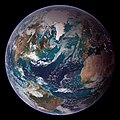Файл:Blue Marble Western Hemisphere.jpg

Розмір при попередньому перегляді: 600 × 600 пікселів. Інші роздільності: 240 × 240 пікселів | 480 × 480 пікселів | 768 × 768 пікселів | 1024 × 1024 пікселів | 2048 × 2048 пікселів | 3718 × 3718 пікселів.
Повна роздільність (3718 × 3718 пікселів, розмір файлу: 2,65 МБ, MIME-тип: image/jpeg)
Історія файлу
Клацніть на дату/час, щоб переглянути, як тоді виглядав файл.
| Дата/час | Мініатюра | Розмір об'єкта | Користувач | Коментар | |
|---|---|---|---|---|---|
| поточний | 11:59, 5 березня 2013 |  | 3718 × 3718 (2,65 МБ) | Szczureq | User created page with UploadWizard |
Використання файлу
Такі сторінки використовують цей файл:
Глобальне використання файлу
Цей файл використовують такі інші вікі:
- Використання в alt.wikipedia.org
- Використання в av.wikipedia.org
- Використання в bn.wikipedia.org
- Використання в ca.wikipedia.org
- Використання в ckb.wikipedia.org
- Використання в cv.wikipedia.org
- Використання в da.wikipedia.org
- Використання в el.wikipedia.org
- Використання в en.wikipedia.org
- Ecological footprint
- User:P3Y229/sandbox
- Wikipedia:Meetup/NYC/AfroCrowd/Home
- Wikipedia:Wikipedia Signpost/2018-10-28/Gallery
- Wikipedia:Wikipedia Signpost/Single/2018-10-28
- User:Lngnbchr/TWA/Earth/2
- User:Saoirse mck/TWA/Earth/2
- User:Northamerica1000/Topics
- User:Nikola Tesla edit/TWA/Earth/2
- User:SDL87/TWA/Earth/2
- User:Mpurcell1/TWA/Earth/2
- User:Mpbrooke/TWA/Earth/2
- User:Tlonedyr
- User:JD Cornbread/TWA/Earth/2
- Використання в en.wikibooks.org
- Використання в en.wikiquote.org
- Використання в en.wiktionary.org
- Використання в es.wikipedia.org
- Використання в eu.wikipedia.org
- Використання в fa.wikipedia.org
- Використання в fi.wikipedia.org
- Використання в fr.wikipedia.org
- Використання в he.wikipedia.org
- Використання в hu.wikipedia.org
- Використання в hy.wikipedia.org
- Використання в id.wikipedia.org
- Використання в it.wiktionary.org
- Використання в ja.wikipedia.org
- Використання в kk.wikipedia.org
- Використання в ko.wikipedia.org
Переглянути сторінку глобального використання цього файлу.


